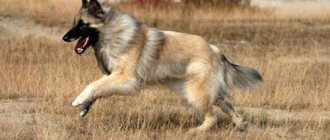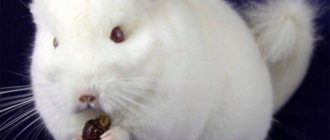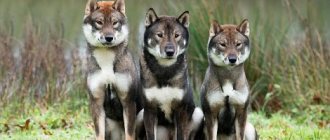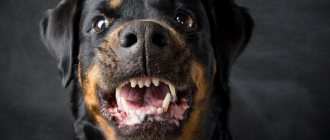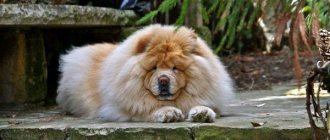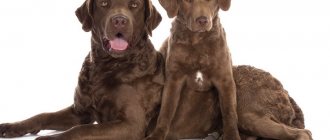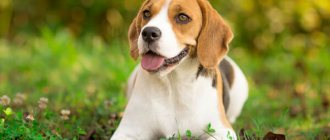Bull Terriers have never been very popular. But in every country they have a narrow and devoted club of fans. In Russia, the Bull Terrier dog breed suffered greatly in the dashing 90s. The reputation was damaged for many years. The nickname “killer dog”, a fighting dog, stuck to them. Until now, when they see a bully, ecstatic ladies grab children and small dogs in their arms in horror, drunk people begin to bully, and some even deliberately incite their dogs, inciting them to fight.
You can assure well-wishers as much as you like that your specific bull terrier will not bite through a paper bag; unhealthy public attention cannot be avoided. Demands to put on a muzzle and remove the dog will become a familiar background noise, like the cries of seagulls.
A complete description of the breed and character traits will help you understand whether a Bull Terrier is right for you. An unusual dog in appearance with a rich inner world, an ideal companion, playmate, sleepyhead and sissy. Why is the bull terrier so dangerous that the stereotype of the “killer dog” turned out to be so tenacious? I'll try to be impartial.
Author of the article: Olga Shiltsova, practicing veterinarian, author of the books “Dachshund of Fate” and “Tails of Fortune”
Short description
Bull Terriers are medium-sized dogs characterized by high levels of activity, energy, strength and endurance.
To meet the breed standard , Bull Terriers must have :
- ovoid, elongated head;
- rounded, sloping skull;
- a large nose with developed nostrils and a black lobe;
- scissor bite;
- small dark brown triangular eyes, set deep and oblique;
- small triangular ears;
- strong muscular neck;
- broad chest;
- short, strong, straight back;
- wide lower back;
- tucked belly.
Bull Terriers have pronounced sexual demorphism - females are much smaller and less massive compared to males.
Breed standard
- In the modern concept, the Bull Terrier is a compact dog with strong, well-developed muscles. In this case, the dog must have an athletic body, its movements are flexible, it moves easily when running.
- The size of representatives of this breed is not limited by the standard, the main thing is that the height and weight are harmonious and correspond to the gender of the animal. Males are slightly larger than females. An adult has a height at the withers of 53 to 56 centimeters. Their minimum weight is eighteen kilograms, and their maximum weight can reach thirty-six kilograms.
- The appearance characteristics of these dogs are slightly different from other representatives of boules. They have a long head with an oval skull and a flat area between the ears, shaped like an egg. They are distinguished by powerful, strong jaws that have a bite similar to a scissor mechanism. Therefore, it is almost impossible to escape from the jaws of such a beast.
- A unique feature of the Bull Terrier breed is the presence of narrow, slanting, deep-set, triangular-shaped eyes. They are located at a considerable distance from the nose. According to the breed standard, dogs' eyes should be a dark shade of brown. Animals with light eye color are not considered purebred and are disqualified from exhibitions.
- The noses of bull terriers have expressive open nostrils, located on the muzzle in a downward direction.
- The ears are positioned straight, vertical, and do not droop. They are planted quite close, have a triangular shape, and are small in size.
- Representatives of this fighting breed have strong, muscular limbs of medium length. The front pair of paws is more developed; they are quite stable. The knees on the hind legs are flexible. The toes are compact and mobile.
- The animal has a short and strong back.
- Bull Terrier tails are not docked; they are set low, short and tapering to the tip.
- The coat of dogs is hard, has little shine, and the hairs themselves are short and straight. During the cold season, the animal develops a soft undercoat.
- There are two color options for the Bull Terrier. White color is classic for this breed, but color variations are also possible. Pigmentation on white fur is allowed. If the animal has a colored coat, the primary color should predominate.
Origin story
Bull Terriers are a breed of dog bred by English breeders after bullfighting was banned in 1835 and people began to organize dog fights in search of spectacle.
Initially, they used bulldogs, but these dogs were too clumsy, so it was decided to create a new breed, the representatives of which would be more compact, dexterous and agile, but at the same time strong and ferocious.
This is how bull and terriers appeared - dogs born as a result of mating a bulldog and a terrier.
In 1850, breeder D. Hinks began improving new dogs.
His goal was to give them a more aristocratic appearance while maintaining their fighting qualities.
In breeding work, he used white Old English terriers, bulldogs, greyhounds, Dalmatians and Scottish collies, crossing them with bull and terriers.
He presented the resulting dog in 1862 at an exhibition in Birmingham, calling the breed “bull terrier”.
Bull Terriers were recognized by the American Canine Organization in 1885..
Staffordshire Bull Terrier
This breed was bred to take part in bullying. Later, when animal fighting was abolished, the Staffordshire Bull Terrier began to be used as a devoted companion.
He has proven himself to be an excellent watchdog. The dog is calm, brave, and intelligent. Loves children. A real nanny.
Is your pet dangerous?
The opinion that representatives of this breed are a priori dangerous and have innate anger, aggression and an unbalanced psyche is a myth.
Of course, these are powerful dogs that, in the heat of rage, can bite a cat without opening their jaws, but before drawing any conclusions, you should learn more about them.
Firstly, the aggressive attitude of representatives of this breed is never directed at people - this was closely monitored at all times and dogs that showed unmotivated anger towards humans were immediately excluded from breeding.
Secondly, even the aggression towards other animals, including cats, inherent in Bullers, can be overcome with proper education and socialization.
The degree of danger of a dog, as well as the adequacy of its behavior, depend only on the owner and how responsibly he approached the issue of raising the pet.
Bull Terrier dog breed: 7 character traits
Notoriety is firmly attached to bull terriers. The paradox is that it is “fighting” dogs that are infinitely friendly to humans. Good or bad, a bull's behavior is always the result of upbringing. But any breed of dog presupposes (besides its specific appearance) a certain temperament. Bull Terriers also have a typical character.
Active
The typical terrier is always full of fire. Shilopopia is inherent in all bull terriers, without exception, even at an advanced age. Such a pet is ready to start a fun romp around the clock. Bulka can even accompany its owner on a bike ride, unless it’s hot outside.
Irrepressible energy must find a way out every day, otherwise the bull terrier will inevitably begin to misbehave. The greatest damage to the environment is caused by young bulls up to 1.5-2 years old.
White bull terrier puppy
Balanced
Aggressive bull terriers are just as unusual as timid ones. An undeniable property of the breed is a stable psyche. The Bull Terrier will never be a lazy sleepyhead, like its ancestor the Bulldog, but according to the type of nervous system it is sanguine, not choleric.
Bulki remain calm in new surroundings and noisy places - if only the owner were nearby. Neither holiday fireworks nor visits to the veterinary clinic bother them.
In dogs, fear often transforms into aggression. But cowardice is absolutely not characteristic of a bull terrier! If a dog grew up affectionately, in a family, it makes no sense to expect “sudden” attacks of aggression from it. The courage of bullies is not expressed in cockiness and the desire to grapple with a larger male. It manifests itself as intelligent calm.
Stubborn
A pronounced character trait of bull terriers is willfulness. This breed is not suitable for people who are looking for an executive servant in a dog.
Like a stubborn child, the Bull Terrier is taught with love and patience. This dog is happy to obey a strong will, but does not follow orders thoughtlessly. Only if you win your pet's heart will the bully be obedient because he wants to please you.
A bull terrier cannot be forced! Don’t get involved in a battle that you will lose; the bully’s donkey tenacity exceeds human patience. The only thing you will achieve is to ruin your relationship with your pet for a long time and lose his trust.
Let's see which of us is more stubborn
With a sense of humor
Some people consider bull terriers to be dull. Fundamentally wrong! Bulkas are really not suitable for search work or agility, but they have high intelligence. It is their lively mind that gives them a mischievous devilry and slyness.
All bull terrier owners claim that their pet has a sense of humor. They know how to make their owner laugh in difficult times, cheer everyone up with their antics and are not offended if they laugh at them. And thanks to the special structure of the muzzle, the bull is the best at smiling. In general, their facial expressions are expressive, like a person’s, and reflect any emotions.
When asked to smile for a photo
Friendly, sociable
The Bull Terrier is an optimist in life, a smiling dog. In terms of friendliness, he will give odds to any Labrador! Bulkas love people, some owners even think that they love them too much. It's hard not to be jealous of your dog when he vigorously wags his tail and exposes his belly to a stranger for a scratch.
Bull Terriers are not suitable for home guarding or as a “bodyguard”. Without special training, they joyfully greet all guests.
Loves his owners
Bull Terriers idolize their owner. They are ready to accompany him anywhere and everywhere, and suffer greatly if they are left alone for a long time. The Bull Terrier's love naturally extends to all household members - including cats and children. Bullies are ideal companions; they are initially focused on communicating with humans. Perhaps this is one of the few dogs that may prefer to play with the owner rather than with their relatives.
Favorite pug
Touchy
It is difficult for an outsider to suspect a subtle mental organization in the “formidable jock”. Nevertheless, it is true. Bull Terriers are very vulnerable. They can become offended, jealous, and depressed if the owner behaves incorrectly with the dog. The Bull Terrier needs a lot of love, affection and attention. And for every harsh word there should be praise tenfold.
Character traits
Bull Terriers can be described as cheerful, affectionate, playful, good-natured and friendly dogs that are characterized by incredible devotion to their owner and his family.
Representatives of this breed find a common language with all household members and get along well with children . They do not show aggression towards people, so they are not suitable as watchmen and security guards.
These dogs are smart and quick-witted, easy to train and quickly remember both commands and rules of behavior established by the owner.
It is necessary to start raising a pet from the first days of his appearance in the house, otherwise he will consider himself to be in charge and will not obey.
Being active and energetic animals, bull terriers need physical exercise, regular walks and active games - without this they literally suffer, which affects both their character and physical and psychological health.
Expert opinion
Kozhevin Semyon Kirillovich
Expert dog handler.
The main thing you need to know when thinking about purchasing a bull terrier is that these dogs have a complex disposition and characteristics of character and behavior that not everyone can cope with. Representatives of this breed are suitable for people with an active lifestyle, who love sports and long walks, who have a strong-willed character, patience and leadership qualities that the dog cannot doubt. Only a person who can properly raise and socialize a pet will be able to raise a bull terrier puppy into a well-mannered dog with a balanced psyche.
Interesting Facts
The following interesting and unusual facts are associated with representatives of this breed:
- Stories about the “death grip” of bull terriers are nothing more than a myth, since it has been proven that representatives of this breed do not have such a feature.
- In 1980, McKenezie the bull terrier, starring in a beer commercial, became a real TV star, winning the hearts of millions of fans around the world.
- The closest relatives of bull terriers are dogs of the Gull terrier breed, which differ from their relatives in being taller and having a different head shape.
- As of 2022 In Spain, Israel, Germany, Ireland and Switzerland, these dogs are prohibited from breeding.
- Bull Terriers are brave and courageous animals. This was proven by a dog named Vila, who served in the police and saved the lives of 33 people.
Advantages and disadvantages
The undoubted advantage of representatives of this breed is that they:
- have a rather extravagant appearance;
- affectionate, friendly and good-natured;
- are not characterized by unmotivated aggression towards people;
- fearless;
- strong and resilient;
- smart and quick-witted;
- are easy to train;
- clean;
- do not require labor-intensive care;
- devoted to the owner.
The disadvantages of bull terriers are their:
- stubbornness;
- aggressive attitude towards other animals, especially cats;
- needs for proper education, early socialization and training;
- intolerance of loneliness;
- tendency to overheat and burns during prolonged exposure to the sun.
It should also be remembered that, despite the fighting background and stereotypes that accompany these dogs, they will not be able to become good watchmen and security guards.
If you want to get a fighting dog
First, you need to decide why such a dog is needed. If she does not participate in dog fights, then it is better to abandon such an idea immediately, especially if there are children in the family. If you start it for the purpose of taking part in competitions, you need to be prepared for the fact that you will have to spend a lot of effort and energy, as well as money.
Dog for fighting
In Russia, for illegal fighting, pit bull terriers are mainly used, which are bred in special nurseries. Parents who could resist in fights are taken as a basis. Naturally, you won’t be able to get into such a nursery just by choice, since you will have to get a recommendation. As a rule, clients of nurseries buy a couple of puppies, both female and male, in order to practice their breeding in the future.
The dog begins to be trained when it reaches 9 months of age, but not later than one year. Each owner has his own training technique to ensure that the result is a fighting dog.
As a rule, the training process includes:
- Strength work on simulators.
- Exercises on a treadmill.
- Grip strength training.
- Carrying out multi-kilometer runs.
Interesting to know! Most owners provide their pets with a balanced diet by creating their own diet, which includes milk with calcium.
It's no secret that organizing fights, especially prohibited ones, is always expensive for dog owners. To take part in such an illegal show, you will have to pay at least 5 thousand rubles, not counting other costs.
And, nevertheless, many are interested in such fights, since the prize fund can be at least 100 thousand rubles, while there can be no more than fifty fans. This suggests that only rich people take part in such shows.
Many claim that many dogs die in such fights, although the organizers of such fights deny everything, pointing out that every owner loves his fighting dog and will never allow this to happen.
Dog for home
To keep a fighting dog at home, it is necessary to train and socialize the animal from an early age. Every day you will have to spend at least an hour and a half on this. A fighting breed of dog must undergo a social training course for protective guard duty. In this case, specialists must assess the dog’s psychotype, as well as its degree of excitability and compliance with the owner’s commands. Experts believe that a dog should stop at the first cry from its owner when it rushes towards a potential source of danger.
It is better to conduct training in open areas, in the absence of strangers and dogs. During the training process, you should be stubborn and strict towards the dog, but in no case should you use physical violence. The execution of each command should be accompanied by rewards. When walking fighting dogs, you should follow a number of rules. The rules state:
- The dog is walked in a muzzle and on a short leash.
- A toy that belongs to a dog should not be given to other dogs.
- In case of aggression, the pet should be taken to the side using a leash.
- In case of conflict situations, the dog can be pulled away by grabbing the lower part of the body, as well as the tail.
A must remember! Fighting dogs require intense physical activity to relieve their internal tension. Walking up to 5 kilometers, a couple of times a day, is especially helpful.
TOP14 The most popular fighting dog breeds + BONUS - OCEAN OF FACTS
What types exist
The International Canine Association distinguishes 3 types of bull terriers:
- dwarf - literally a smaller version of the standard English bull terrier, their coat can be tri-colored, white or tan;
- English – active, energetic and agile dogs with white fur;
- Staffordshire - dogs that are distinguished by a large supply of energy, but at the same time they are rather slow animals; their coat can be brindle, black, red and white, brown, red, etc.
All types of bull terriers are independent breeds.
Main characteristics
| Breed parameters | |
| Country of origin: | Great Britain |
| Weight of the breed: | mini boules: 9–15 kg, large boules: 23–32 kg |
| Height at withers: | mini boules: 25–35.5 cm, large boules: 53–56 cm |
| Temperament: | active |
| Wool: | short |
| Role in human life: | bodyguard, watchman |
The English Bull Terrier has a smaller brother in size - the Mini Bull Terrier. The pet has a difficult character - this is true. A loving, active, playful dog often shows stubbornness and tries to dominate its owner. But without special training, the dog will not show aggression. With proper upbringing, negative traits can be easily minimized.
Color variations
The coat of bull terriers is distinguished by a variety of colors, the most common of which are:
- white, possibly having colored spots on the head;
- ginger;
- black;
- bicolor;
- tricolor;
- brindle.
NOTE!
Individuals with gray, fawn, blue coat colors and white dogs with spots not located on the head cannot participate in exhibitions and breeding.
Dog skin pigmentation is not important.
Bull Terrier appearance: not for everyone
The long, egg-shaped head is the first thing that catches your eye. The Bull Terrier's profile is a smooth arc from the top of the head to the tip of the nose. The triangular eyes are deep-set and appear tiny. The ears should stand upright.
Bull Terriers have the most recognizable profile of all dogs.
The Bull Terrier is a real athlete, this impression is created by its compact body with developed muscles. The legs are absolutely straight and the chest is wide. They are divided into standard and miniature bull terriers by size. Minibulls weigh 8-16 kg, for standard ones the weight is not limited and ranges from 20-36 kg.
The smooth short coat of Bull Terriers is shiny and coarse. The skin does not gather in folds anywhere, fitting tightly to the body. Until 1919, the only recognized color was white. Now there are no restrictions on color; a bull terrier can be two-color, three-color, red, brindle. Colored colors were obtained using Staffordshire bull terriers in breeding.
Madam, are you free tonight?
Many owners affectionately call their dogs “piglets,” and indeed there is a definite similarity.
Nutritional Features
Both natural products and industrial food are suitable for feeding bulldogs. The choice of food type depends on the owner and his ideas about what is healthier for the dog.
The only rule that must be followed is that the diet must be balanced and contain all the necessary vitamins and minerals.
In the case of natural feeding, the diet of bull terriers should consist of:
- dietary meat (beef, veal, poultry);
- vegetables, fruits and herbs (carrots, pumpkins, beets, spinach, parsley, apples);
- chicken or beef offal (liver, lung, tripe, trachea, heart);
- raw eggs;
- boiled sea fish;
- cereals (rice, buckwheat);
- fermented milk products (ryazhenka, cottage cheese, kefir, natural yogurt, curdled milk);
- hard cheese as a treat and reward for following commands.
Bull Terriers are prohibited from eating:
- fatty meat;
- smoked meats, pickles, marinades;
- sweets, chocolate;
- seasonings;
- river fish;
- potatoes;
- citrus fruits;
- raisins and grapes;
- spicy and fried foods;
- bakery, sausage and pasta products;
- legumes
A natural diet involves additional intake of a vitamin-mineral complex.
When feeding your pet with finished products, you should choose food in accordance with the age, physiological state and health of the dog.
The food must be at least premium class, since budget products contain harmful chemical additives that negatively affect the health of the animal.
The best food for bull terriers – Orijen, Acana, Bozita, Genesis, GO!, Grandorf.
Feeding
Puppies grow quite quickly, gaining height by nine months. After this age, the animal's development consists of muscle development. What should a bull terrier's diet be?
Remember that this breed quickly gains excess body weight. Eventually:
- the breed requires one meal per day;
- Be sure to teach your pet to seek food only when hungry;
- do not add more food than you should;
- do not offer gourmet foods so as not to spoil your pet;
- the main part of the diet is natural meat products;
- the second part of the meal is foods with minerals and calcium.
Health and major diseases, life expectancy
Bull Terriers have good immunity and good health, but they are not protected from absolutely all diseases. Most often, representatives of this breed develop pathologies caused by genetics.
Such diseases include:
- deafness;
- cleft palate and upper lip;
- copper toxicosis;
- blepharophimosis;
- acrodermatitis;
- hypoplasia of the larynx;
- hypothyroidism;
- dislocation of the elbow and kneecaps;
- polycystic kidney disease;
- joint dysplasia;
- skin allergic reactions;
- epilepsy;
- sarcoma of the mammary glands;
- inversion and inversion of the eyelid;
- astigmatism;
- mitral valve dysplasia;
- aortic stenosis;
- mastocytoma.
The average lifespan of bull terriers is 10-15 years.
Proper education at home
People themselves are to blame for the opinion that the bull terrier is aggressive. Only improper upbringing of a puppy leads to negative consequences, first of all, for the owner himself.
It is possible to properly raise a Bull Terrier at home, but for this it is important for the dog owner to know a few basics:
- Puppy training needs to be done from an early age (3 months);
- The dog must not be hit;
- It is forbidden to encourage bull terrier aggressiveness;
- When handling a dog, a calm, friendly tone of the owner, as well as strict discipline, is important;
- A bull terrier needs long walks. Ideally, each walk will last at least 2 hours;
- You cannot restrict your dog from playing with his brothers.
Since the Bull Terrier has a confident and strong character, it is more suitable for men. It is not recommended for single women to get bull terrier puppies, as well as for elderly people who are not always able to adequately raise a fighting dog.
Suitable for living in an apartment or outdoors?
Representatives of this breed are not very large dogs, so they feel quite comfortable living in city apartments or country houses, if they are provided with daily active walks.
Representatives of this breed are not suitable for outdoor keeping because they do not tolerate heat or frost well..
A long stay in the sun threatens them with overheating and sunburn, and in winter, even during a short walk, they need warm clothes.
Is it worth starting
The Bull Terrier is not a breed for everyone. The small size of a pet does not change the puppy's character traits. It will take a lot of time for training and walks. A pet needs an owner with a backbone and leadership qualities. It is not recommended to purchase a puppy for teenagers or older people.
The character of English Bulls has pros and cons, but does not allow for a cold attitude from the owner. Despite his stubbornness, the puppy needs love constantly. You will have to give a small piece of life to your pet. In modern living conditions, few are willing to give a lot of time to a dog.
The most suitable type of owner for a puppy is a young, active person with experience in dog breeding. A young family with older children is also perfect for adopting an English Bull.
Education and training
When raising a bull terrier, you need to show him your superiority and leadership, but you cannot beat or otherwise humiliate the dog.
For successful training, the pet must be motivated by something; most often, the reward is treats that are treated to it after completing the command..
| Team | Education |
| Sit | After the command is pronounced loudly and clearly, you need to show your pet the treat so that he raises his head and sits down. If the need arises, you can apply a little more pressure to his croup. Then you should repeat the command, praise the dog and give it a treat. |
| To me | You should start mastering the command only after the pet remembers its nickname and begins to associate itself with it. You need to choose a moment when the bull terrier is at a distance, but at the same time in the field of view, say a command and, as it were, “lure” him. When your dog approaches, it is important to praise him and give him a treat, reinforcing the positive association. |
| Lie | This command is mastered similarly to the “sit” command, the only difference is in the position of the dog |
| Near | The purpose of this command is to teach the dog to walk next to the owner, holding on to his left leg. The right time for training is almost the end of the walk, when the pet is not yet physically exhausted, but is already quite tired from playing and running. You need to tighten the leash and hold the dog so that it walks to the left of the owner, not allowing it to go to the side, overtake or fall behind him |
| Place | This command should be practiced before bedtime, when the dog is in the bed. You need to leave the pet in place, say the command and leave, making sure that the dog does not follow, but remains in the bed. Over time, you need to complicate the task by using a command and leaving the bull terrier in any other place in the house and outside it |
The key to successful training is regularity, consistency and proper distribution of the load.
Disadvantages of Bull Terriers: what you need to know in advance
Breeders warn: everything in the world must be in balance. The Bull Terrier will delight, touch and delight you. And just as often he will infuriate you, sometimes driving you to despair.
Deliberate disobedience
Even a well-bred bull terrier can experience bouts of “selective deafness” that will drive you crazy. Having learned and perfected a command, the dog simply stops following it.
Boule will test your strength throughout your life, trying to expand the boundaries of what is permitted. Over time, you will get used to it, and you will be reminded who is boss in passing. But you can't give in. If you forbid your dog to beg, and another day, after thinking, you throw a piece from the table - this is a failure. Be consistent, decide in advance and clearly what is possible and what is not.
Am I not the boss of the house?
Can't stand loneliness
Getting a bull terrier is about the same as bringing a three-year-old child into the house. You don’t leave your children alone for 8-12 hours, do you? And if you leave it, then don’t be surprised at the destruction in the apartment. A young bull terrier, out of boredom and anxiety, gnaws on everything it comes across. It’s especially good if the item has the scent of a departed owner – that’s why the shoes are the first to suffer.
Powerful jaws are capable of crushing a wooden chair into small splinters, and natural stubbornness does not allow the bull to stop until all the linoleum is torn off the floor. If the bull terrier does not agree to stay in a locked room, he will break down the door with his cast iron head. Most often - successfully.
It is worth thinking about your schedule in advance if you are taking a bull terrier puppy into your home. And abandon this idea if you are not ready to devote enough time to the dog.
A puppy in the house is not only a great joy, but also a great responsibility.
Unhealthy public attention
Wherever you go with your bull terrier, there will be those who have read the yellow press at one time. Even at a dog park, owners may ask you to put your “killer” on a leash, even if the dog is only 6-7 months old... The situation is aggravated by the fact that most people do not distinguish between 4 different breeds of dogs:
- The English Standard Bull Terrier is what we are talking about in this article;
- English Staffordshire Bull Terrier;
- American Pit Bull Terrier, pit bull;
- American Staffordshire Terrier, Amstaff.
You will hear phrases like “Pona, “Hold him, don’t you see, my toy/sneeze/Yorkie is throwing himself!” You will need a lot of patience and a lot of self-control. And if you don’t have these qualities, then you shouldn’t have a bull terrier.
Lifehack for bull terrier owners: funny pet costumes will help calm down Grandma Galya from the next apartment and mothers from the playground
Look, I'm white and fluffy, a harmless bull
It's hard to be afraid of someone in an elf unicorn costume
Your dog will always be under close attention, so his reputation must be crystal clear. God forbid you forget your poop bag at home or run towards a flock of pigeons. What is forgivable for a cute beagle or fluffy Samoyed is not forgivable for a bull terrier.
Features of care
Bull Terriers are short-haired dogs, so grooming them requires minimal effort.
However, it is still necessary to regularly carry out hygiene procedures, since both the appearance and health of the pet depend on it..
Wool and bathing
The coat of these dogs should be brushed with a stiff brush with natural bristles 2-3 times a week.
Short hair does not get tangled, but regular brushing improves blood circulation and helps get rid of dust and dead hair.
You should wash your pet’s paws after every walk, but give him a full bath with a mild shampoo no more than once a quarter..
Teeth
In order to prevent the formation of plaque and stones, you should brush your pet's teeth weekly using a special brush and toothpaste for dogs.
Eyes
Wipe daily with a cotton pad soaked in boiled water, removing discharge from the corners of the eyes.
Claws
If the nails do not grind down to the required length during walks, they need to be trimmed once every 3-4 weeks with a guillotine nail clipper.
Ears
Wipe the inside of the ear once a week with a damp cotton pad.
CAREFULLY!
There is no need to use cotton swabs to clean your ears - careless movement can cause deafness.
Mating
Puberty occurs when the dog is 7-16 months old, but mating is recommended only at the age of one and a half years. The bitch comes into heat twice a year, mating is allowed on the 13-15th day, when obvious signs of readiness are visible: swelling of the loop, secretion of light secretions, “invitation” of the male to movements of the tail and hips.
- Before mating, it is necessary to remove worms from dogs and examine them for diseases and pathologies. In addition, it is important to choose pets that will complement each other’s good qualities and correct the negative ones. For the first time, you can invite a specialist.
- Animals are bred in the male territory. Since the weight of the female and male differs, it is difficult for the girl to stand under the male, she is supported by the stomach. The boy is sent to the noose. "Castle" may or may not happen. Sexual intercourse does not last more than 3-5 minutes; the “lock” can last up to 30 minutes. It is necessary to support the pets so that no one tries to lie down or wriggle out, this can injure the genitals.
- After mating, dogs may experience nausea, trembling, or increased appetite. This is not scary, but if the symptoms last more than 1 day, you need to contact a veterinarian.
- Mating is repeated after 2-3 days.
How to choose?
Bull Terriers are a popular and widespread breed of dog, so finding a kennel that specializes in breeding them is not difficult. You should not buy a puppy from your own hands - in this case there is no guarantee of its health and purebred.
In a healthy, standard puppy:
- 6 teeth each on the upper and lower jaws;
- large egg-shaped head;
- scissor bite;
- small triangular eyes;
- smooth and shiny coat;
- clean eyes and skin.
Rash, scratching, dandruff, bloated belly, increased lacrimation, unpleasant odor from the ears, nasal discharge indicate the presence of any pathologies in the puppy.
You should test your puppy's hearing by clapping your hands or using a squeaky toy and assessing his reaction.
Possible health problems
Large English Bulls and Miniatures have the same problems. The health of dogs is good compared to other breeds. But there are certain problems.
Common diseases affecting puppies include deafness. Deafness in one or both ears is possible. Deaf pets are not used for breeding: deafness is inherited.
Mini boules may suffer from exophthalmos (displacement of the eyeball). This feature can be eliminated by inbreeding. The dwarf variety is crossed with the standard variety, since large pets do not have a problem.
Dogo Canario
As the name implies, the breed originated in the Canary Archipelago from crossing local dogs with Molossians. This is a fairly balanced dog, although it is prohibited from being imported into a number of countries.
The somewhat phlegmatic-looking Dogo Canary will readily take a decisive pose and show considerable swiftness for play or exercise. Since their nervous system is in perfect order, they usually don’t start fights, but if someone catches a Great Dane, the unfortunate bully won’t care.
Some people are afraid of the Dogo Canario breed, but in most cases, the dog’s inappropriate behavior is the result of inadequate upbringing. Yes, there have been fatal cases involving people, but a properly socialized dog will never attack a person unless provoked.
This smart breed takes training easily, but in order to raise a dog that is safe for others, you need to take specialized courses.
This is a one-owner dog, so there must be a clear leader in the human family. Otherwise, the dog will realize that there is no commander in chief and will do as he pleases.
Video: Dogo Canario
Dogo Argentino
The Argentine, despite his impressive appearance, is quite tolerant of strangers. Although this does not matter, because strangers try to avoid this big dog without any warning.
But for the owner, the Dogo Argentino is a faithful and reliable companion with the character of a true aristocrat.
The Argentine has one peculiarity - he is quite demanding of attention in his direction. The dog will climb onto your lap and ask for affection in every possible way. And this is with its dimensions! Need I say that the owner should not drive the dog away? But it is better not to introduce such a dog to other pets.
However, with all these qualities, Great Danes are quite independent and often strive to show a dominant character. You will have no time left for hobbies, much less TV - the dog constantly needs long walks and good physical exercise.
Because of its attachment to its owner, the Dogo Argentino is an excellent bodyguard.
Video: Dogo Argentino



